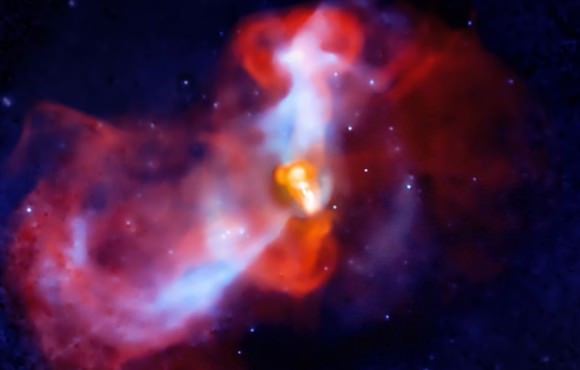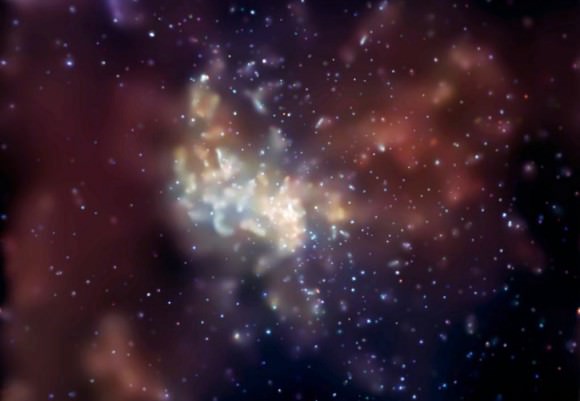Scientists have long suspected that supermassive black holes (SMBH) reside at the center of every large galaxy in our universe. These can be billions of times more massive than our sun, and are so powerful that activity at their boundaries can ripple throughout their host galaxies.
In the case of the Milky Way galaxy, this SMBH is believed to correspond with the location of a complex radio source known as Sagittarius A*. Like all black holes, no one has even been able to confirm that they exist, simply because no one has ever been able to observe one.
But thanks to researchers working out of MIT’s Haystack Observatory, that may be about to change. Using a new telescope array known as the “Event Horizon Telescope” (EHT), the MIT team hopes to produce this “image of the century” very soon.Initially predicted by Einstein, scientists have been forced to study black holes by observing their apparent effect on space and matter in their vicinity. These include stellar bodies that have periodically disappeared into dark regions, never to be heard from again.
As Sheperd Doeleman, assistant director of the Haystack Observatory at Massachusetts Institute of Technology (MIT), said of black holes: “It’s an exit door from our universe. You walk through that door, you’re not coming back.”

As the most extreme object predict by Einstein’s theory of gravity, supermassive black holes are the places in space where, according to Doeleman, “gravity completely goes haywire and crushes an enormous mass into an incredibly close space.”
To create the EHT array, the scientists linked together radio dishes in Hawaii, Arizona, and California. The combined power of the EHT means that it can see details 2,000 times finer than what’s visible to the Hubble Space Telescope.
These radio dishes were then trained on M87, a galaxy some 50 million light years from the Milky Way in the Virgo Cluster, and Sagittarius A* to study the event horizons at their cores.
Other instruments have been able to observe and measure the effects of a black hole on stars, planets, and light. But so far, no one has ever actually seen the Milky Way’s Supermassive black hole.
According to David Rabanus, instruments manager for ALMA: “There is no telescope available which can resolve such a small radius,” he said. “It’s a very high-mass black hole, but that mass is concentrated in a very, very small region.”
Doeleman’s research focuses on studying super massive black holes with sufficient resolution to directly observe the event horizon. To do this his group assembles global networks of telescopes that observe at mm wavelengths to create an Earth-size virtual telescope using the technique of Very Long Baseline Interferometry (VLBI).

- Image of Sagittarius A*, the complex radio source at the center of the Milky Way, and believed to be a SMBH. Credit: NASA/Chandra
“We target SgrA*, the 4 million solar mass black hole at the center of the Milky Way, and M87, a giant elliptical galaxy,” says Doeleman. “Both of these objects present to us the largest apparent event horizons in the Universe, and both can be resolved by (sub)mm VLBI arrays.” he added. “We call this project The Event Horizon Telescope (EHT).”
Ultimately, the EHT project is a world-wide collaboration that combines the resolving power of numerous antennas from a global network of radio telescopes to capture the first image ever of the most exotic object in our Universe – the event horizon of a black hole.
“In essence, we are making a virtual telescope with a mirror that is as big as the Earth,” said Doeleman who is the principal investigator of the Event Horizon Telescope. “Each radio telescope we use can be thought of as a small silvered portion of a large mirror. With enough such silvered spots, one can start to make an image.”
“The Event Horizon Telescope is the first to resolve spatial scales comparable to the size of the event horizon of a black hole,” said University of California, Berkeley astronomer Jason Dexter. “I don’t think it’s crazy to think we might get an image in the next five years.”
First postulated by Albert Einstein’s Theory of General Relativity, the existence of black holes has since been supported by decades’ worth of observations, measurements, and experiments. But never has it been possible to directly observe and image one of these maelstroms, whose sheer gravitational power twists and mangle the very fabric of space and time.
Finally being able to observe one will not only be a major scientific breakthrough, but could very well provide the most impressive imagery ever captured.


Let’s say we place a number of space telescopes in orbit around the sun where they would orbit perpendicular to SgrA*. You could effectively have a 3 AU telescope aiming at SgrA*. Tell me how much more effective that would be rather than using a virtual telescope as big as Earth.
Technically, you could do this. But optical interferometry isn’t easy, and would be a massive challenge on the scale you’re describing…
http://www.astronomycast.com/2009/03/ep-129-interferometry/
“These include stellar bodies that have periodically disappeared into dark regions, never to be heard from again.” “Dark Regions” or “Black Holes”? Source please.
An image of the apparent horizon produced by networked radio telescopes? Can anyone provide a link to images of a star using only radio telescopes at half the distance being talked about here? Let’s see that resolution and image as a rough baseline.
The resolution we would be looking for would show the same detail as images produced of at least Jupiter or Saturn from Earth based telescopes. If all we see is a bright light of a few pixels, no questions will come close to being answered.
We should see patches of variable flareups of high energy particles as material falls into the apparent horizon. If enough material is falling in, the shape of the apparent horizon should take on a spherical geometry.
If we don’t see at least this, black holes will remain an unobserved theory.